Poop color guide. The Ultimate Guide to Poop Color, Consistency, and What It Means for Your Health
What does your poop color indicate about your health. How can you use the Bristol Stool Chart to assess your digestive wellness. Why do changes in stool consistency occur and when should you be concerned.
Understanding the Basics of Healthy Poop
Poop, also known as stool, is a natural byproduct of our digestive system. It consists of undigested food, proteins, bacteria, salts, and other substances produced and released by the intestines. While it may not be a topic for polite conversation, understanding your poop can provide valuable insights into your overall health.
What constitutes a healthy poop? Several factors come into play:
- Color: Typically brown due to bile and bilirubin
- Shape: Generally log-like
- Size: A couple of inches in length
- Consistency: Between firm and soft
- Duration: Should take only a minute or so to pass
- Frequency: Anywhere from every other day to three times a day
Decoding Poop Colors: What They Reveal About Your Health
The color of your stool can be a window into your digestive health. While brown is the most common and generally healthy color, variations can occur:

- Brown: Normal and healthy
- Green: Often normal, may indicate rapid transit through the intestines
- Black: Could be due to certain foods or medications, or indicate upper GI bleeding
- Red: May suggest lower GI bleeding or consumption of red-colored foods
- Yellow: Possible malabsorption issues or Gilbert’s syndrome
- White or clay-colored: Could indicate bile duct obstruction
Are changes in poop color always a cause for concern? Not necessarily. Temporary changes often result from diet or medication. However, persistent unusual colors, especially black or red, warrant medical attention.
The Bristol Stool Chart: A Visual Guide to Poop Consistency
The Bristol Stool Chart, developed in 1997, provides a visual guide to understanding stool consistency. It categorizes stools into seven types:
- Type 1: Separate hard lumps (severe constipation)
- Type 2: Lumpy and sausage-like (mild constipation)
- Type 3: Sausage-shaped with cracks (normal)
- Type 4: Smooth, soft sausage (ideal)
- Type 5: Soft blobs with clear-cut edges (lacking fiber)
- Type 6: Fluffy pieces with ragged edges (mild diarrhea)
- Type 7: Entirely liquid (severe diarrhea)
How can you use the Bristol Stool Chart to assess your digestive health? By comparing your stool to the chart, you can gain insights into your digestive function and potential issues. Types 3 and 4 are considered optimal, while persistent occurrences of other types may indicate dietary imbalances or digestive problems.

Frequency Matters: How Often Should You Poop?
Bowel movement frequency varies among individuals. While some people may go three times a day, others might only go three times a week. What’s considered normal?
Generally, a healthy range is anywhere from three times a day to three times a week. However, consistency is key. Your personal “normal” is what’s regular for you. Significant changes in frequency could signal digestive issues.
Can bowel movement frequency affect your health? Both too frequent and too infrequent bowel movements can impact well-being:
- Constipation (less than three times a week) can lead to discomfort, bloating, and potentially more serious complications if chronic.
- Frequent bowel movements (more than three times a day) may indicate digestive disorders, food intolerances, or excessive caffeine intake.
The Impact of Diet on Your Poop
Your diet plays a crucial role in determining the quality and consistency of your stool. How does what you eat affect your poop?

- Fiber: Increases stool bulk and promotes regularity
- Water: Helps soften stool and prevent constipation
- Probiotics: Support healthy gut bacteria, potentially improving stool consistency
- Certain foods: Can change stool color (e.g., beets can cause reddish stools)
What dietary changes can improve your poop health? Consider these tips:
- Increase fiber intake through fruits, vegetables, and whole grains
- Stay hydrated by drinking plenty of water
- Include probiotic-rich foods like yogurt or kefir in your diet
- Limit processed foods and excessive caffeine or alcohol
When to Worry: Red Flags in Your Poop
While variations in poop are normal, certain signs should prompt medical attention. What are the red flags to watch for in your stool?
- Blood in the stool (red or black color)
- Persistent changes in bowel habits
- Severe or chronic diarrhea
- Unexplained weight loss accompanied by changes in stool
- Pale or clay-colored stools
- Severe abdominal pain associated with bowel movements
Should you keep a poop diary? In some cases, particularly if you’re experiencing digestive issues, tracking your bowel movements can provide valuable information for your healthcare provider.

The Gut-Brain Connection: How Stress Affects Your Poop
The connection between your gut and brain is more significant than you might think. How does stress impact your digestive system and, consequently, your poop?
Stress can affect your gut in several ways:
- Altering gut motility, potentially leading to diarrhea or constipation
- Increasing inflammation in the digestive tract
- Changing the gut microbiome composition
- Exacerbating symptoms of digestive disorders like IBS
What strategies can help manage stress-related digestive issues? Consider these approaches:
- Practice stress-reduction techniques like meditation or deep breathing
- Engage in regular physical activity
- Ensure adequate sleep
- Consider cognitive-behavioral therapy if stress significantly impacts your digestive health
Poop and Your Microbiome: The Role of Gut Bacteria
Your gut microbiome, the complex ecosystem of bacteria residing in your digestive tract, plays a crucial role in your overall health, including the quality of your poop. How does your microbiome affect your stool?

- Influencing stool consistency and frequency
- Aiding in the breakdown of certain foods
- Producing beneficial compounds like short-chain fatty acids
- Protecting against harmful pathogens
Can you improve your gut microbiome for better poop health? Consider these strategies:
- Consume a diverse range of plant-based foods
- Include fermented foods in your diet
- Consider a probiotic supplement (consult with a healthcare provider first)
- Avoid unnecessary antibiotic use, which can disrupt the microbiome
The Importance of Fiber for Gut Health
Fiber is a crucial component for maintaining a healthy digestive system and producing well-formed stools. How does fiber contribute to poop health?
- Adds bulk to stool, making it easier to pass
- Promotes regular bowel movements
- Feeds beneficial gut bacteria
- Helps maintain a healthy gut lining
What are some fiber-rich foods to include in your diet?
- Whole grains (oats, quinoa, brown rice)
- Legumes (beans, lentils, chickpeas)
- Fruits (apples, pears, berries)
- Vegetables (broccoli, carrots, Brussels sprouts)
- Nuts and seeds
Hydration and Its Impact on Stool Consistency
Proper hydration is essential for maintaining healthy bowel movements. How does water intake affect your poop?

- Softens stool, making it easier to pass
- Helps prevent constipation
- Aids in the absorption of water-soluble nutrients
- Supports overall digestive function
How much water should you drink for optimal digestive health? While individual needs vary, a general guideline is to aim for 8 glasses (64 ounces) of water per day. However, factors like climate, physical activity, and overall health can influence your hydration needs.
Digestive Disorders and Their Effect on Poop
Various digestive disorders can significantly impact the appearance and consistency of your stool. What are some common conditions that affect poop?
- Irritable Bowel Syndrome (IBS): Can cause alternating constipation and diarrhea
- Inflammatory Bowel Disease (IBD): May lead to bloody stools and chronic diarrhea
- Celiac Disease: Can result in fatty, foul-smelling stools
- Colorectal Cancer: May cause narrow, pencil-thin stools
How can you differentiate between normal variations and potential digestive disorders? Pay attention to persistent changes in bowel habits, unexplained weight loss, or the presence of blood in stools. If you experience these symptoms, consult a healthcare provider for proper evaluation.

The Role of Probiotics in Digestive Health
Probiotics, live beneficial bacteria, can play a significant role in maintaining digestive health and potentially improving stool quality. How do probiotics benefit your gut?
- Restoring balance to the gut microbiome
- Reducing inflammation in the digestive tract
- Potentially alleviating symptoms of certain digestive disorders
- Supporting immune function in the gut
What are some natural sources of probiotics?
- Yogurt with live cultures
- Kefir
- Sauerkraut
- Kimchi
- Kombucha
Should everyone take probiotic supplements? While probiotics can be beneficial, it’s essential to consult with a healthcare provider before starting any supplement regimen, as individual needs may vary.
Poop and Your Overall Health: What Your Stool Says About You
Your poop can serve as a window into your overall health, potentially indicating issues beyond just digestive concerns. What can your stool reveal about your health?
- Nutrient absorption: Fatty, oily stools may indicate malabsorption issues
- Liver function: Pale stools could suggest liver or gallbladder problems
- Hormonal imbalances: Changes in stool consistency may occur during menstruation or pregnancy
- Medication effects: Certain drugs can alter stool color or consistency
How often should you pay attention to your poop? While you don’t need to scrutinize every bowel movement, being generally aware of your typical patterns and noting significant changes can help you stay attuned to your health.

The Importance of Proper Toilet Posture
Believe it or not, how you sit on the toilet can impact your bowel movements. What’s the ideal posture for pooping?
- Lean forward slightly
- Keep your knees higher than your hips (a small stool can help achieve this)
- Relax your pelvic muscles
- Avoid straining
Why does posture matter? Proper toilet posture can help:
- Reduce straining and the risk of hemorrhoids
- Facilitate more complete emptying of the bowels
- Potentially alleviate constipation
- Support overall colon health
Children’s Poop: What’s Normal and When to Worry
Children’s stools can vary significantly from those of adults, and what’s normal can change as a child grows. What should parents know about their children’s poop?
- Infants: Breastfed babies often have frequent, loose stools, while formula-fed babies may have firmer, less frequent bowel movements
- Toddlers: As solid foods are introduced, stools become more formed and may vary in color
- School-age children: Should have regular, formed stools
When should parents be concerned about their child’s poop? Watch for:
- Persistent diarrhea or constipation
- Blood in the stool
- Significant changes in stool color or consistency
- Signs of discomfort during bowel movements
If you notice these signs, consult with your child’s pediatrician for proper evaluation and guidance.

The Future of Poop Analysis: Emerging Technologies and Research
As our understanding of the gut microbiome and its impact on overall health grows, so does the potential for using stool analysis as a diagnostic tool. What emerging technologies and research are shaping the future of poop analysis?
- Microbiome sequencing: Analyzing the genetic material of gut bacteria to assess digestive health
- Metabolomics: Studying the chemical fingerprints left behind by cellular processes in stool
- Smart toilets: Devices that can analyze stool composition and provide health insights
- Fecal biomarkers: Identifying specific compounds in stool that may indicate various health conditions
How might these advancements benefit healthcare in the future? Potential applications include:
- Early detection of digestive disorders and colorectal cancer
- Personalized nutrition recommendations based on gut microbiome composition
- More targeted treatments for digestive issues
- Improved understanding of the gut-brain axis and its impact on overall health
As research in this field continues to evolve, we may gain even more insights into how our poop can serve as a valuable indicator of our overall health and well-being.

Identifying Types of Poop with the Bristol Stool Chart and More
Your stool is basically undigested food, proteins, bacteria, salts, and other substances produced and released by your intestines. What your poop looks like can be important. It could indicate if you’re healthy or have an underlying medical condition.
We all do it. For some, it’s a necessary inconvenience. For others, it’s a pleasant and satisfying part of the digestive process. It has fascinated toddlers since time immemorial, and there’s a reason for that.
Going number two might not be the prettiest topic for a dinner party, but there’s a lot to learn from this mundane yet mysterious, process. In the end (no pun intended), it’s simply a part of our functioning body.
So, what exactly is poop? Although everyone is unique in the size, shape, and smell of their poop, there are a few things that indicate a healthy (or unhealthy) poop.
Healthy poop can be as varied and as unique as the individuals who make it. But there are a few general rules to follow if you want to assess your poo artistry for optimum health.
But there are a few general rules to follow if you want to assess your poo artistry for optimum health.
Color
The poop emoji has one thing right: the brown coloring. The combination of stomach bile and bilirubin, which is a pigment compound formed from the breakdown of red blood cells in the body, gets the credit for this oh-so-lovely shade of brown.
Shape
A somewhat log-like shape is how most poop should come out due to its formation within the intestines. However, as we’ll get to later, there are a variety of shapes that poop can have.
When they differentiate from the log shape, that’s when your poop is trying to tell you something’s up.
Size
Poops shouldn’t come out in small pellets — something else we’ll get to later — but instead should be a couple of inches in length, and comfortable and easy to pass.
Consistency
Anywhere between a firm and soft consistency is pretty much normal. If it sways too much one way or another, it could suggest some digestion or fiber issues.
Length of time
A commonly heard joke is that when someone takes too long in the bathroom, it must mean they’re pooping. A healthy poop, however, should be easy to pass and take only a minute or so to push out.
That said, some people do spend a bit more time on the toilet, so as a general rule, a poop should take no more than 10 to 15 minutes.
Frequency
Fun fact: Did you know most people poop around the same time every day?
On average, a person with healthy digestion will poop anywhere between every other day to three times a day. Any less could suggest possible constipation. This means you need some more water to move the “boat.”
The Bristol stool chart is an overarching indicator of how and why different types of poops look or feel a certain way. It’s broken up into seven categories based on a 2,000-person study published back in 1992, and it makes poop knowledge basic and easy to understand.
Share on Pinterest
Type 1: Marbles
Appearance: Hard and separate little lumps that look like nuts and are hard to pass.
Indicates: These little pellets typically mean you’re constipated. It shouldn’t happen frequently.
Type 2: Caterpillar
Appearance: Log-shaped but lumpy.
Indicates: Here we have another sign of constipation that, again, shouldn’t happen frequently.
Type 3: Hot dog
Appearance: Log-shaped with some cracks on the surface.
Indicates: This is the gold standard of poop, especially if it’s somewhat soft and easy to pass.
Type 4: Snake
Appearance: Smooth and snake-like.
Indicates: Doctors also consider this a normal poop that should happen every 1 to 3 days.
Type 5: Amoebas
Appearance: Small, like the first ones, but soft and easy to pass; the blobs also have clear cut edges.
Indicates: This type of poop means you’re lacking fiber and should find ways to add some to your diet through cereal or vegetables.
Type 6: Soft serve
Appearance: Fluffy and mushy with ragged edges.
Indicates: This too-soft consistency could be a sign of mild diarrhea. Try drinking more water and electrolyte-infused beverages to help improve this.
Type 7: Jackson Pollock
Appearance: Completely watery with no solid pieces.
Indicates: In other words, you’ve got the runs, or diarrhea. This means your stool moved through your bowels very quickly and didn’t form into a healthy poop.
As with size and consistency, poop’s color can be a helpful signal about what’s going on within your body. As we previously mentioned, varying shades of brown are what’s considered the norm.
Even a hint of green is considered healthy. But if your poop is veering toward other ends of the rainbow, you might want to assess.
Share on Pinterest
Black
If you’ve had licorice, iron supplements, or bismuth medications (such as Pepto-Bismol), that could be the explanation behind black stool. If you haven’t had any of that, black poop could be a sign of bleeding in the upper gastrointestinal tract.
If you haven’t had any of that, black poop could be a sign of bleeding in the upper gastrointestinal tract.
It may seem like red would be a more likely color for this sort of concern, but since it’s taken a while to travel down, it’s older and therefore darker.
Green
While hints of green are quite normal, if your poop has gone from brown to full green, it may mean one of two things. Either you’ve added lots of green foods like spinach to your diet, or your stools passing through you too fast. When it doesn’t pick up as much of the brown-tinting bilirubin, it has more bile salts that turn it this color.
Pale, white, or clay
If your poop is a chalky light shade, it might mean you’re lacking bile. Bile is a digestive fluid that comes from your liver and gallbladder, so if you’re producing white stool, it probably means your duct is blocked.
Pale poop could also be a side effect of certain medications like antidiarrhea medicine. Either way, if it continues, consult a doctor.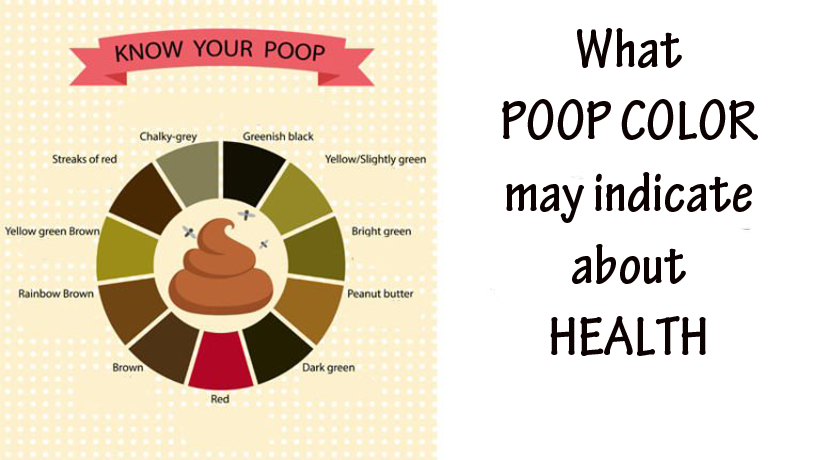
Red
You’re probably not surprised to hear that red poop can mean bleeding, either due to hemorrhoids or to bleeding in the lower intestinal tract. If your stool is a little red, however, there may be no need to immediately fret.
There are other, less serious reasons for this change in color. Foods like beets, cranberries, red gelatin, or tomato juice can turn poop red as well.
Yellow
Greasy, stinky, yellow stool is typically a sign of too much fat. This could also be a direct relation to a malabsorption disorder like celiac disease, where your body isn’t absorbing enough nutrients.
If your poop looks bright yellow, it could signify a condition called giardiasis, which is caused by an intestinal parasite in North America and the world. Typically, you can get giardiasis from contaminated water or exposure to a person with the condition.
Every now and again, when you take a look in the toilet bowl, you’ll see poop bobbing like a toy sailboat in the bathtub.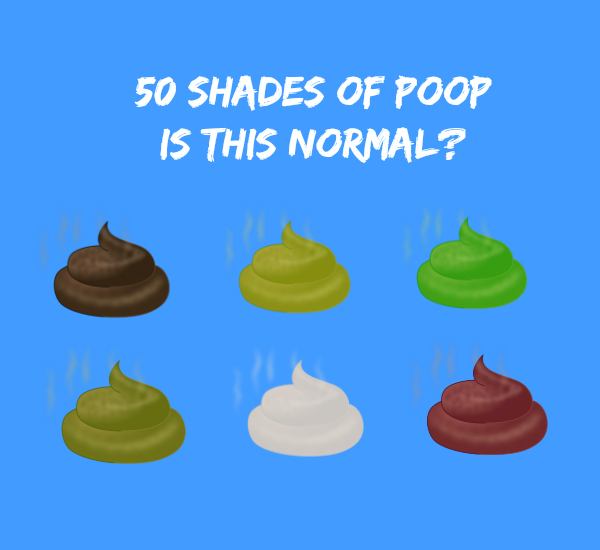 As alarming as this seems, all it means is that the stool is less dense than the others that sink.
As alarming as this seems, all it means is that the stool is less dense than the others that sink.
One potential reason for this lack of density can come from an increased amount of gas or water, or even a high fiber diet.
It’s also possible that malabsorption is, once again, the reason for a floating stool. If this is the case, the other abnormalities previously mentioned, like slight constipation, might also be present.
Constipation is defined as having less than three bowel movements per week.
There could be many reasons you experience this lack of pooping. Nerve issues in and around the colon or rectum may slow down pooping, as can problems with pelvic muscles. Conditions that affect hormones, like pregnancy or diabetes, could also be the culprit.
If you’re experiencing this clogged-up feeling, you can add more high fiber foods to your diet, like beans, vegetables, fruits, and whole grains. Drinking lots of fluids, staying active, and managing stress can also help alleviate constipation.
If a diet change doesn’t seem to get things moving, constipation could be caused by certain medications or even a blockage in the bowel. Talking with a doctor is the best course of action to find relief in this instance.
A green poop here or hard poop there happens to the best of us. It’s when this type of irregularity carries on for more than a day or two that you should take action and talk with a doctor. The same goes for changes in color or consistency, or constipation.
Chronic constipation can obstruct the bowels, while chronic diarrhea can make it difficult for a person to absorb necessary nutrients from food. Both chronic constipation and chronic diarrhea could even be a sign of more serious conditions.
Again, the first sign of either of these should not be immediate cause for concern, but keep an eye on it and see if it lasts more than a few days.
That said, pay attention to any signs of blood. If you haven’t eaten any of the foods mentioned above that could turn your poop this color, talk with a doctor immediately.
As quick as we are to write it off, our poop can provide a wealth of knowledge about our health and ourselves. So next time you pop a squat, take note of what’s going on. The toilet bowl is a window into your health and you.
Read this article in Spanish.
Emily Rekstis is a New York City-based beauty and lifestyle writer who writes for many publications, including Greatist, Racked, and Self. If she’s not writing at her computer, you can probably find her watching a mob movie, eating a burger, or reading an NYC history book. See more of her work onher website, or follow her onTwitter.
Stringy Poop: Causes, Treatments, and More
You can learn a lot about your health from the appearance of your stool. Stringy stool may be caused by something simple, such as a low fiber diet. In some cases, the cause is more serious.
Stringy poop may also be referred to as stools that are pencil-thin, ribbon-like, thin, or narrow.:max_bytes(150000):strip_icc()/healthy-and-unhealthy-stool-89211-color-V1-9cef9502a0a5433994307575289f34c7.png) Normal stool is about 1 to 2 inches in diameter. Stringy poop is narrow and, in some cases, almost flat, giving it a stringy appearance. It may be solid or loose.
Normal stool is about 1 to 2 inches in diameter. Stringy poop is narrow and, in some cases, almost flat, giving it a stringy appearance. It may be solid or loose.
Stringy poop may or may not be accompanied by other gastrointestinal symptoms, such as:
- stomach pain
- cramping
- nausea
- blood in the stool
There are several reasons your stool may be thin.
Constipation
Constipation may be caused by a low fiber diet and lack of fluids. Fiber adds bulk to stool, increasing its size. If you don’t eat enough fiber or drink enough fluids, stool loses its bulk and may become thin and stringy.
Symptoms
There are a number of symptoms that signify constipation, including:
- fewer than three bowel movements a week
- hard, dry, or lumpy stools
- stools that are difficult or painful to pass
- feeling as though not all stool has passed
Treatment
If the stringy stool is caused by constipation, drinking plenty of water and eating more fiber-rich foods should help. Some fiber-rich foods are:
Some fiber-rich foods are:
- bran
- legumes
- seeds
- fresh fruits and vegetables
Increasing your fiber intake may be as simple as making a few changes to your diet.
- Whole grains, like bran, whole wheat, or oats, are an easy way to increase your fiber. When buying groceries, look for a whole-grain bread, pasta, or cereal.
- Getting your recommended daily servings of fruits and vegetables can also help you increase your fiber intake. Look for fruits and vegetables with 5 or more grams of fiber.
- Beans are another great source of fiber. Throw beans in a salad or add them to whole-grain rice for a fiber-rich meal.
If necessary, you may also take a fiber supplement.
Need help choosing a fiber supplement: What’s the best fiber supplement? »
Colorectal cancer
Some people may be concerned when they see stringy stool because they’ve read or been told it’s a symptom of colorectal cancer. However, the American Cancer Society says that stringy stool, as well as other symptoms of colon cancer, can be caused by noncancerous problems such as infections, hemorrhoids, and irritable bowel syndrome.
However, the American Cancer Society says that stringy stool, as well as other symptoms of colon cancer, can be caused by noncancerous problems such as infections, hemorrhoids, and irritable bowel syndrome.
Symptoms
Some symptoms of colorectal cancer may include:
- rectal bleeding
- changes in bowel habits
- the persistent urge to have a bowel movement
- cramping in the abdomen or belly
- weakness and fatigue
- losing weight without trying
While many of the above symptoms may not be due to colon cancer, it’s important to be checked by a medical professional if you are experiencing them.
Treatment
Treatment for colorectal cancer depends on the stage. Early-stage cancer may be resolved with minimally invasive surgery. Invasive colorectal cancer may be treated by removing part of the colon and the surrounding lymph nodes. Chemotherapy, radiation therapy, and targeted drug therapy may also be used.
Irritable bowel syndrome
Irritable bowel syndrome (IBS) may cause changes in bowel habits, leading to thin stools.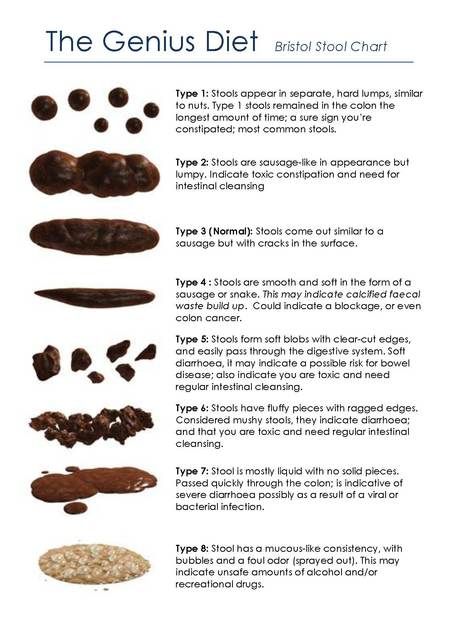 It may also cause mucus in your stools, which can give poop a stringy appearance.
It may also cause mucus in your stools, which can give poop a stringy appearance.
IBS is also known as a spastic colon. It is not linked to inflammatory bowel disease (IBD) or other bowel conditions. Rather, IBS is defined as gastrointestinal symptoms that show up together. Symptoms appear differently in every person, including in severity and duration. However, the standard duration is at least 3 months. The exact cause of IBS is still unknown.
Symptoms
IBS symptoms aren’t always constant, and may present on an intermittent basis. As well, symptoms may resolve only to return. IBS is associated with a number of common symptoms, including:
- cramping
- abdominal pain
- bloating and gas
- constipation
- diarrhea
Treatment
Treatments for IBS are primarily focused on symptom management:
- diet changes
- antidepressants
- probiotics
- a balanced diet
- anti-constipation medication
- anti-cramping medications
Intestinal infections
Some intestinal infections such as salmonella, gastroenteritis, and shigellosis may cause loose stools or diarrhea. You may get one of these infections through ingesting contaminated food or water, or coming into contact with someone who is sick.
You may get one of these infections through ingesting contaminated food or water, or coming into contact with someone who is sick.
Symptoms
Intestinal infections may be marked by the following symptoms:
- nausea
- vomiting
- fever
- loss of appetite
- muscle aches
- dehydration
- headache
- mucus or blood in the stool
Treatment
If stringy poop is caused by a parasite or other infection, you may need medication to clear it up. Most parasites are treated with anti-parasitic drugs. Some are eliminated in one treatment, while others require treatment for several weeks.
Salmonella and other intestinal infections often clear up on their own in several days. In severe cases, your doctor may prescribe antibiotics or antidiarrheal medications. It’s also important to drink plenty of water to replenish fluids lost due to vomiting and diarrhea.
Additional causes
These other conditions may cause narrowing in the colon and lead to stringy stools:
- fecal impaction
- colon polyps
- trapped abdominal hernias
- anorectal strictures, or a narrowing between the rectum and anus
- distended or stretched colon
- twisted bowel or volvulus
Some intestinal parasites, such as giardia, may cause loose, thin stools. If you have a parasite, you may have other symptoms such as:
If you have a parasite, you may have other symptoms such as:
- cramping
- nausea
- weight loss
- fatigue
Conditions that cause inflammation in the colon, such as Crohn’s disease or ulcerative colitis, may cause loose, thin stools and diarrhea.
Stringy stool may also occur for no obvious reason.
When the cause of stringy poop is serious, such as a bowel obstruction or hernia, you’ll need urgent care. A combination of surgery and medication may be needed.
There’s no reason to call your doctor if you have occasional stringy stool. If it happens for more than a week, or you also have vomiting, fever, abdominal pain, or rectal bleeding, you should call your doctor. They will discuss your symptoms and determine if tests or treatment are needed.
Tests to determine the cause of stringy poop may include:
- fecal occult test to check for blood in your stool
- stool sample test to check for the presence of parasites or bacteria
- blood tests to rule out celiac disease
- flexible sigmoidoscopy to examine your lower colon
- colonoscopy to examine your entire colon
- X-ray with contrast (barium) to view your gastrointestinal tract
- CT scan to view your abdominal organs
Most people experience stringy poop at least once. In most cases, the outlook is good. When the condition is sporadic and you do not have other symptoms, it’s likely nothing to worry about and should resolve on its own within a short period of time.
In most cases, the outlook is good. When the condition is sporadic and you do not have other symptoms, it’s likely nothing to worry about and should resolve on its own within a short period of time.
When stringy poop is caused by a serious condition, your outlook depends on how quickly you receive care and the extent of the damage. In many cases, dietary changes, medication, surgery, and good aftercare successfully resolves symptoms.
When it comes to poop, the important thing is for you to know what is normal for you. If you’ve never had stringy poop before and suddenly have it regularly, contact your doctor.
complete guide to baby poop
© Liza Streltsova
A topic that worries all parents
Parenthood changes everyone. Just yesterday, you smugly chuckled at those who write panicky questions about “tight-hearted” and “pokakusiki” on the Internet, and today you are frantically comparing the contents of your baby’s diaper with photographs on the Internet. All young parents are worried about the health of their baby – and we will help you save your nerves and time searching.
All young parents are worried about the health of their baby – and we will help you save your nerves and time searching.
So here’s what’s important to know about baby poop in the first months of life. First, the feces of a breastfed infant and a formula fed infant will differ. Secondly, the vast majority of shades that you can find in a diaper are completely normal for a child’s immature digestive system. Let’s figure out what should not cause you anxiety.
It is called meconium and appears during the first couple of days after childbirth. In appearance and consistency, meconium resembles engine oil and can cause genuine horror in young parents. Don’t worry, everything is fine with your baby, he has parted with the last reminder of life in the womb, and is now ready for further development of the digestive system.
Most commonly, healthy breastfed babies will have mustard-like stools, sometimes with a yellowish, orangey, or greenish tint. All this is perfectly normal. Please note that the consistency of baby stool is more often liquid and heterogeneous – this is also normal. You should not believe those who romantically say that infant stool smells like milk or something else pleasant – its smell is still quite specific, although it differs from the smell of an adult’s stool or children who have already switched to adult food.
Please note that the consistency of baby stool is more often liquid and heterogeneous – this is also normal. You should not believe those who romantically say that infant stool smells like milk or something else pleasant – its smell is still quite specific, although it differs from the smell of an adult’s stool or children who have already switched to adult food.
In artificially fed children, the stool is slightly more formed than in naturalists, but still remains soft. Yellow, yellow-brown, light brown or greenish stools are considered normal. And yes, formula-fed stool smells a lot more like real poop.
Once you start introducing complementary foods into your baby’s diet, be prepared for the fact that his stool will change, and become more and more like what you usually see in your toilet bowl. Also, do not forget that children’s stool often takes on the color of what was eaten: for example, orange after carrots or pumpkins and a reddish hue after beets. So if you find a poop of a non-standard color, then before you panic, remember what you fed the baby the day before.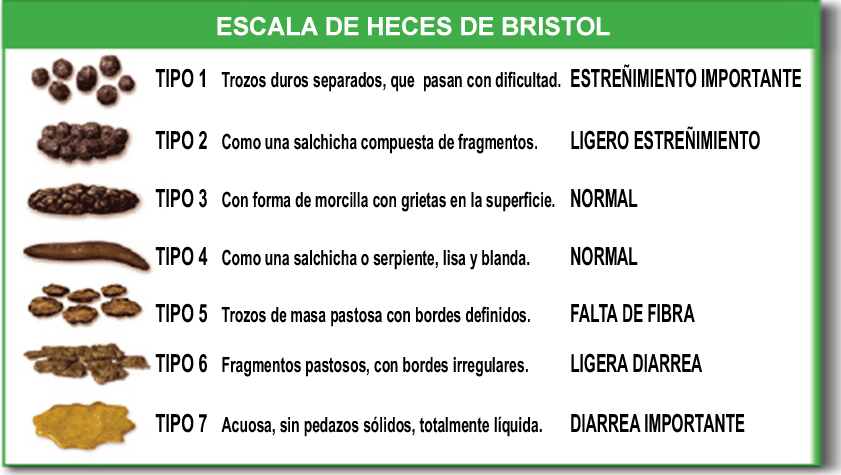
If you have several consecutive stools in the diaper that look greener and thinner than usual, this most likely indicates that the child has diarrhea. In babies, it can occur in case of drastic changes in the diet (of a child or mother if she is breastfeeding), and sometimes it can indicate food allergies or intolerances. Severe and frequent diarrhea (and also if it is accompanied by other symptoms such as pain and abdominal pain, vomiting and fever) may indicate food poisoning or infection and requires the attention of a doctor.
Sometimes the baby’s stools may turn yellowish or greenish and the texture may become more mucus. Often this indicates increased salivation in a child – for example, when teething. Mucus from saliva is not digested in the children’s stomach and comes out in its original form. However, if the mucous stool persists for a long time, and the child does not feel very well, it may indicate an intestinal virus, and in this case it is better to consult a doctor.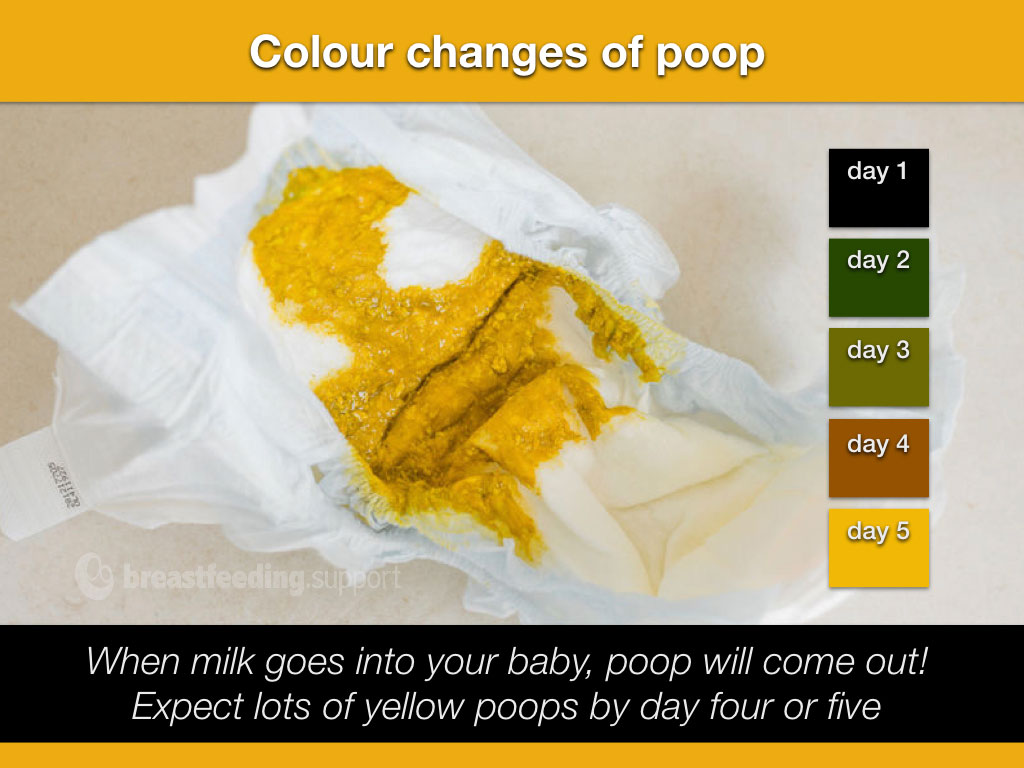
If there are hard dark balls in the baby’s diaper (to be fair, the chances of you seeing them increase significantly after the introduction of complementary foods), then this indicates constipation. Sometimes there may still be traces of blood on them – this is due to the fact that they hardly pass through the anus. Constipation suggests that you need to increase the child’s drinking regimen and, possibly, consult a pediatrician.
All the listed colors of the baby chair should not cause you much anxiety (especially if they are not accompanied by any other problems and ailments). However, there are several varieties of poop that are very likely to say that something went wrong.
When red or pinkish streaks are found in a baby’s stool, it may be blood. Blood appears in the stool for various reasons: for example, if there are cracks or wounds somewhere in the child’s rectum or anus, or if the child has an intestinal infection. Also, sometimes mothers with cracked nipples can detect blood in the baby’s stool – a baby with milk eats some blood, and then it comes out the other end.
If your child has very dark and thick stools (and by age it is no longer meconium), then it may indicate intestinal bleeding, and the child should definitely be shown to the doctor. But first, remember if your child is taking iron supplements (or a formula fortified with iron), they also usually make the stool darker and thicker.
White or very light stools are rare in children and almost always indicate a problem. Sometimes light stools indicate problems with the liver, in other cases – about an allergy or an intestinal virus. It is also not uncommon for stools to become lighter from taking antibiotics or antacids. However, in any case, if your child has a light stool (and is also accompanied by other restless symptoms), this is a reason to consult a doctor.
Read more on the topic
- 0-6 months
- health
The color of the stool in a child – what does light, green or black stool indicate?
The characteristics of the baby chair are influenced by such indicators as age, type of feeding, and developmental features of the baby. At the same time, a change in the shade, consistency of the stool, the appearance of an unpleasant odor may indicate the presence of a particular pathology. Let’s talk about which stool changes are a variant of the norm, and which are a cause for concern.
At the same time, a change in the shade, consistency of the stool, the appearance of an unpleasant odor may indicate the presence of a particular pathology. Let’s talk about which stool changes are a variant of the norm, and which are a cause for concern.
Child’s eating habits
If a child notices an unusual stool color, parents should also pay attention to the color of the urine and the general well-being of the baby. If the urine has not become more saturated, and the child is active and cheerful, then the changes are most likely associated with the food eaten the day before.
If we are talking about a baby who feeds on mother’s milk, then it is the mother herself who should analyze the diet. In formula-fed babies, stool changes may be due to the fact that the parents decided to introduce a new mixture.
In older children who eat at the same table with adult family members, unusual stools are also most often associated with eating certain foods. Calcium-rich food contributes to the staining of feces in a light color, increasing its viscosity. For example, many kids love cottage cheese with sour cream. Eaten the day before, such a snack helps to lighten and increase the viscosity of feces – it becomes like clay.
For example, many kids love cottage cheese with sour cream. Eaten the day before, such a snack helps to lighten and increase the viscosity of feces – it becomes like clay.
The cause of green stool in a child may be eating a large amount of green vegetables, as well as lettuce leaves. Brick-red staining is often due to the fact that the child went too far with red berries or tomatoes. Blackcurrants and blueberries can cause very dark stools.
Other causes
Pediatricians say that the appearance of light-colored feces in a child may be due to the eruption of milk teeth. The exact causes of this process remain not fully understood, but the fact remains. Young mothers should remember about this feature of the child’s body. However, if you are in doubt about a change in stool color, it is best to consult your pediatrician. Remember that the period of teething is often accompanied by an increase in susceptibility to various infections, including enteroviruses.
Also, if the color of the child’s feces changes, parents should remember whether they gave him any medications the day before. Some drugs stain the stool: for example, the use of iron-containing products is associated with the appearance of greenish-black stool.
Some drugs stain the stool: for example, the use of iron-containing products is associated with the appearance of greenish-black stool.
Finally, healthy children’s feces may darken and lighten periodically. If the baby’s well-being does not suffer at the same time and the color of the feces returns to normal within a couple of days, then you should not sound the alarm.
The child’s stool color has changed – maybe something is wrong?
Features of feces often indicate certain pathological processes. And sometimes a change in color, smell and other characteristics are the only symptoms that prompt a pediatrician to think about the correct diagnosis.
Dysbacteriosis
Dysbacteriosis is a disorder of the intestinal microflora. The shift in the species ratio of bacteria towards symbionts, which are normally present in small quantities, cannot but affect the properties of feces. In children suffering from dysbacteriosis, the stool becomes watery, with an admixture of a mucous character, lighter than normal.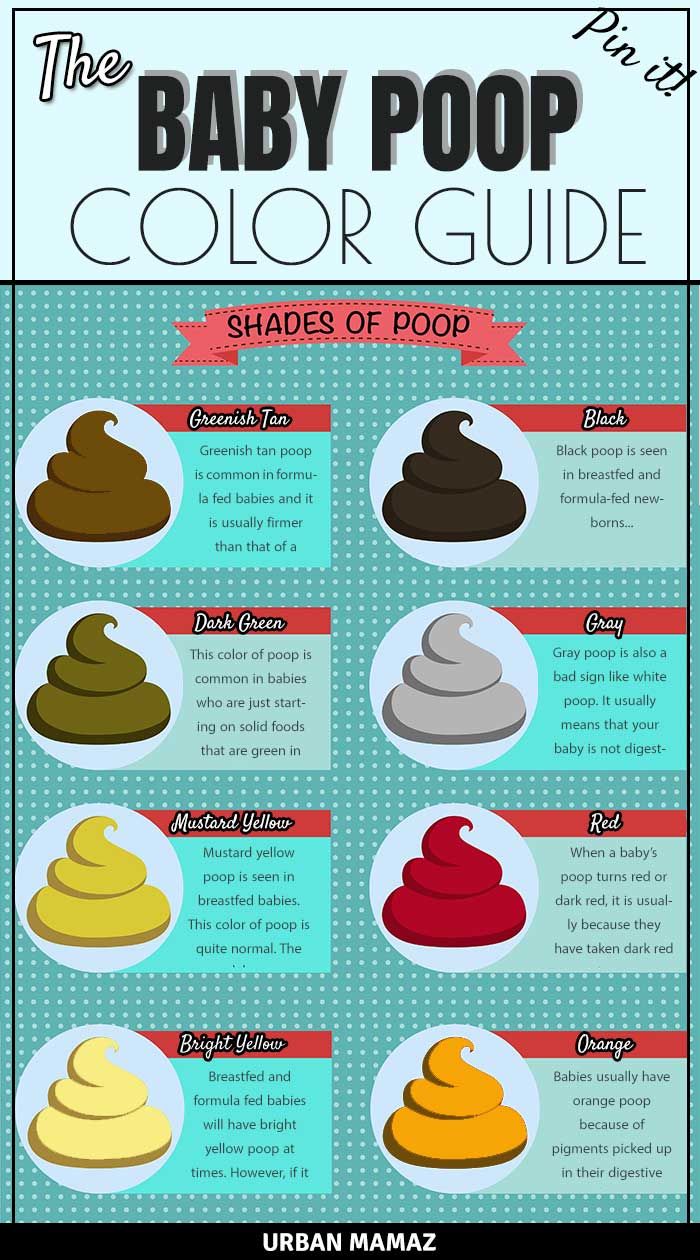 In severe cases, the feces can become frothy, acquire a sharp unpleasant odor.
In severe cases, the feces can become frothy, acquire a sharp unpleasant odor.
These symptoms are often accompanied by pain in the abdomen, increased gas formation – the general condition of the child suffers. To solve the problem as soon as possible, you need to see a doctor.
Hepatitis
Hepatitis in children and adults may present with a characteristic greyish discolored stool. In order to exclude the presence of hepatitis in a child, when light stool appears, parents should pay attention to the color of the urine. Discolored stools, caused by a malfunction of the liver cells, are always accompanied by the release of saturated urine (the so-called “beer-colored” urine).
If warning symptoms appear, you should not panic – only a specialist can make a diagnosis of hepatitis. But there is no need to delay visiting the pediatrician. The doctor will prescribe a diagnostic plan and give the necessary recommendations.
Pancreatitis
Many people think that only adults suffer from pancreatitis.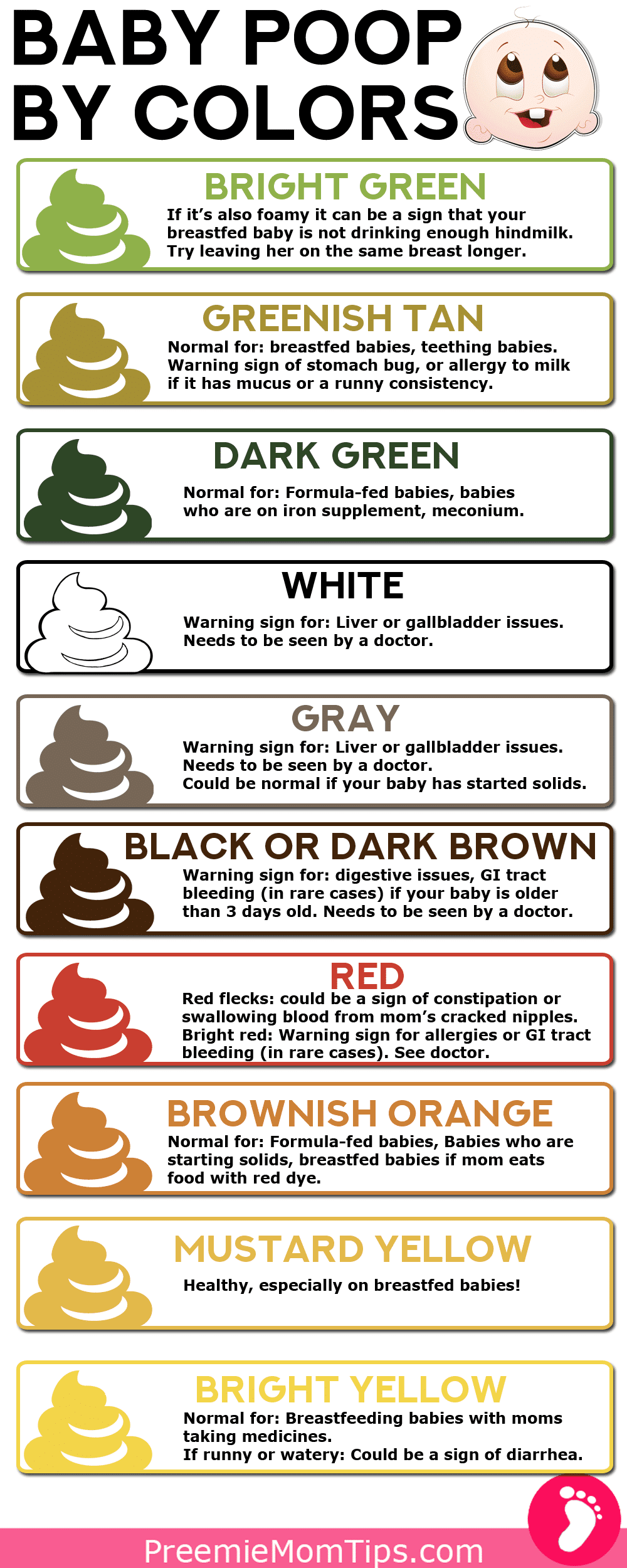 But, unfortunately, inflammation of the pancreas can occur at any age. Cal at the same time acquires a grayish tint, an unpleasant odor. In chronic pancreatitis, the total amount of excreted feces is increased, and it itself acquires a kind of oiliness, it is poorly washed off.
But, unfortunately, inflammation of the pancreas can occur at any age. Cal at the same time acquires a grayish tint, an unpleasant odor. In chronic pancreatitis, the total amount of excreted feces is increased, and it itself acquires a kind of oiliness, it is poorly washed off.
In a classic attack of pancreatitis, pain in the abdomen of a girdle character (or localized in the umbilical region) is also observed. There are also symptoms of dyspepsia:
- loss of appetite;
- nausea and vomiting;
- increased gas formation.
Also, children may experience a slight increase in body temperature, pale skin, dry mouth. An attack of pancreatitis can be triggered by excessive consumption of chocolate, cocoa, carbonated drinks, fresh vegetables.
Bent gallbladder
Bent gallbladder is a fairly common congenital anomaly. The bend of the gallbladder may be asymptomatic. Manifestations of pathology can appear after heavy consumption of food, especially fatty. Children are worried about vomiting with an admixture of bile, pain in the right side.
Children are worried about vomiting with an admixture of bile, pain in the right side.
The bending of the gallbladder is characterized by alternating periods of constipation and diarrhea. With a pronounced inflection, the feces may become lighter than normal.
Rotavirus infection
This viral infectious disease is accompanied by intoxication (its signs are weakness, fever, general malaise) and symptoms of gastrointestinal lesions. The latter include pain, nausea, repeated vomiting, rumbling in the abdomen. At the same time, the child’s stool is plentiful, it becomes watery, frothy, has a greenish-yellow color and a pungent odor. As a rule, pathological impurities are absent or there is a small amount of mucous inclusions.
Vomiting and diarrhea in children can cause severe dehydration very quickly. This condition is extremely dangerous for children, therefore, if the above symptoms appear, seek medical help immediately.
Whipple’s disease
This rare infectious disease is accompanied by damage to the lymphatic system of the small intestine and articular syndrome.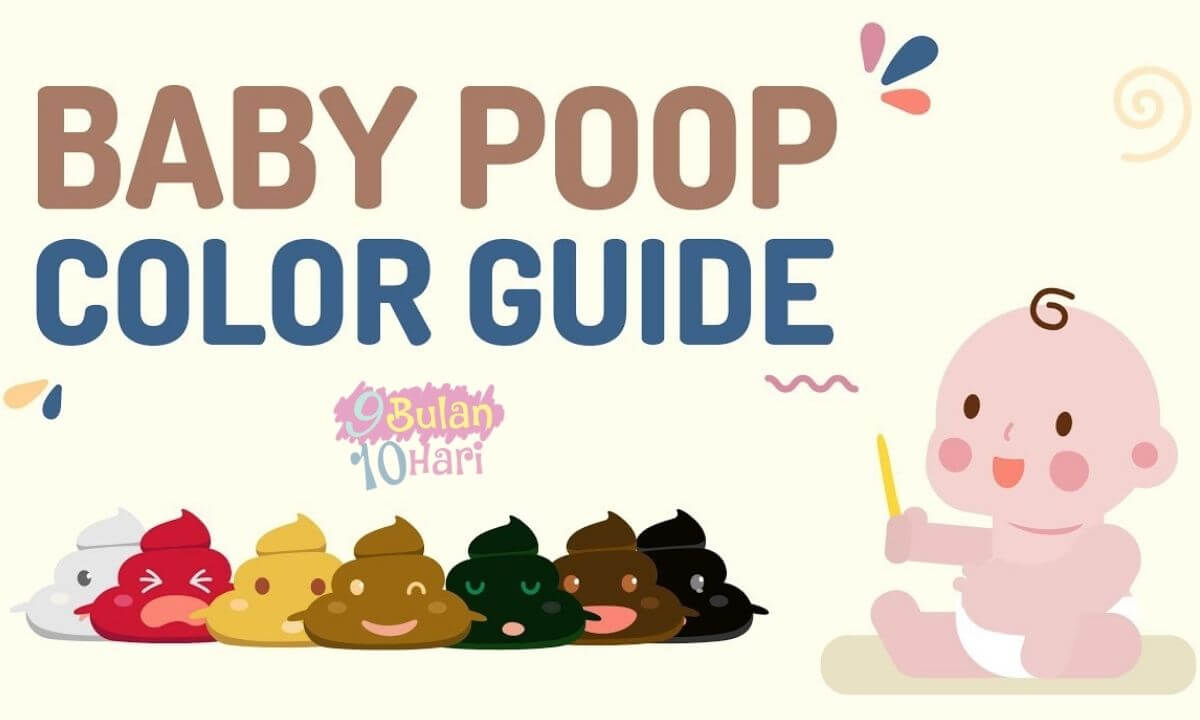 Whipple’s disease occurs with marked fever, abdominal pain, flatulence, nausea, and vomiting. The stool is liquid, defecation occurs up to 10 times a day, the stool has a grayish tint and a pungent odor.
Whipple’s disease occurs with marked fever, abdominal pain, flatulence, nausea, and vomiting. The stool is liquid, defecation occurs up to 10 times a day, the stool has a grayish tint and a pungent odor.
Is it necessary to go to the doctor if there is a change in the color of feces in children?
Since a change in the characteristics of the feces in a child can often be a variant of the norm, parents should act depending on the circumstances of the particular case. Attentive mothers and fathers can easily notice the connection between a change in stool and a previously eaten product or medication the day before. Even if the nature of the feces has changed for no apparent reason, but the child feels normal, it is worth observing him for 1-2 days. Perhaps the stool will normalize on its own.
In all other cases, when a change in the color and other properties of feces is accompanied by abdominal pain, fever, nausea, pallor of the skin and any other pathological signs, it is necessary to consult a pediatrician as soon as possible. Acute diseases in children can progress at a very high rate, so refusing to consult a specialist can be deadly.
Acute diseases in children can progress at a very high rate, so refusing to consult a specialist can be deadly.
Foamy stool in an infant
Foamy stool in an infant is a sign of a deficiency in the normal intestinal microflora. Without the right amount of beneficial bacteria, the physiological process of digestion becomes impossible, and the consistency of the stool changes.
Microflora imbalance may be temporary, transient. In this case, the condition is normalized without special treatment. In more serious cases, the doctor may prescribe drugs from the group of pro- and prebiotics. Finally, dysbacteriosis in combination with foamy stools is often one of the symptoms of an intestinal infection, especially if the child complains of abdominal pain, fever, and deterioration in the general well-being of the baby.
Diarrhea in infants
Newborns have loose stools due to infectious and non-infectious causes.
Diarrhea of an infectious nature has the following features:
- pronounced unpleasant odor;
- foaminess;
- increase up to 8-10 times a day;
- combination with nausea and vomiting, fever.

Causes of non-infectious diarrhea in an infant include:
- lactose intolerance;
- violations of the diet by a nursing mother;
- reaction to unusual complementary foods.
Constipation in infants
Normally, a baby’s feces are soft, but constipation can occur as early as the first month. If a child of the first year of life (and especially the first four weeks) has difficulty passing feces, parents should consult a pediatrician. Constipation in an infant may be a sign of one of the pathologies:
- Hirschsprung’s disease. In this disease, there is a violation of the innervation of the rectum. The main symptoms of the disease are increased gas formation and recurrent constipation, the appearance of which is not associated with a change in the nature of nutrition.
- Anal fissure, irritation of the perianal zone. In this case, each act of defecation gives the child severe discomfort, therefore, at the psychological level, the baby can be restrained – constipation forms.

In addition, excessive use of microenemas and the gas tube can lead to constipation. Sometimes parents, sincerely caring about the child, trying to relieve him of constipation, use special assistive devices almost every day. However, such actions can irritate the delicate skin of children in the anus, which indirectly can further aggravate the problem of constipation.
Occult blood in the stool
The presence of a significant amount of blood in the stool is not so difficult to recognize. Bleeding from the lower gastrointestinal tract (with anal fissure, ulcerative colitis) is manifested by bright red streaks. If the source of bleeding is higher (esophagus, stomach), the stool turns black.
Occasionally, stool may be normal in color and consistency, but may contain microstreaks of blood. This condition must be identified and treated, as the child regularly loses blood (even in microscopic amounts), which can provoke the development of iron deficiency anemia.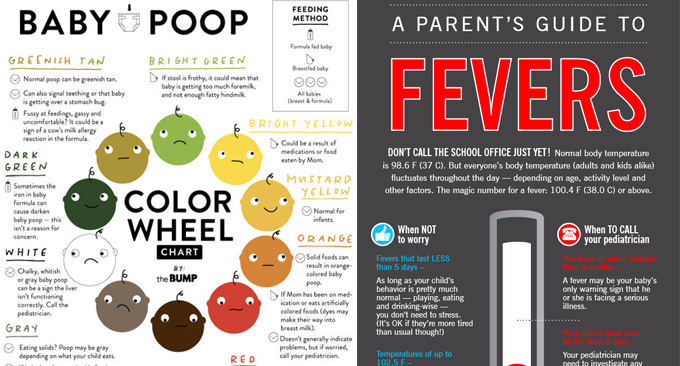
A pediatrician orders a fecal occult blood test, mainly because of a suspected gastrointestinal food allergy. The intestinal mucosa in young children is very delicate, so it is easily damaged by allergens. Especially frequent appearance of blood microveins in the feces is associated with the action of such generally recognized allergens as soy, chicken egg, wheat, seafood, cow’s milk protein, peanuts.
Stools with mucus and strong odor
Mucus is a lingering secretion produced by the mucous membrane of the intestinal wall. With the help of mucus, the intestines are protected from the aggressive effects of the external environment, the pH of which differs from the norm in the acid or alkaline direction.
Few people know that reduced mucus content in feces can also lead to problems – cause constipation. However, parents are more concerned about the high content of mucus in the feces of the child.
The appearance of an admixture of a mucous nature may be one of the signs:
- Acute respiratory infection.
 Young children, who are not yet able to blow their nose and cough, swallow nasal mucus and phlegm. This mucus is excreted along with the stool.
Young children, who are not yet able to blow their nose and cough, swallow nasal mucus and phlegm. This mucus is excreted along with the stool. - Teeth eruption. At the same time, saliva is actively secreted, which can also contribute to the appearance of mucous secretions.
Mucus in a child’s stool should not cause great concern to parents, since most often this sign does not indicate serious health problems.
Pieces of undigested food in the stool
Pieces of food in the stool of a child also often cause anxiety in parents. The logic of mothers and fathers is simple: if the baby could not digest the food to the end, then perhaps he has problems with the work of the stomach and he does not receive enough nutrients. However, such judgments are not entirely correct.
The causes of the appearance of undigested food particles can be:
- Physiological (age-related) deficiency of enzymes. Some periods of a child’s development are accompanied by a temporary deficiency of enzymes.
 But this does not mean that the child does not receive enough proteins, fats and carbohydrates. As you get older, your enzyme levels will normalize and your stools will become smooth.
But this does not mean that the child does not receive enough proteins, fats and carbohydrates. As you get older, your enzyme levels will normalize and your stools will become smooth. - Eating foods that, in principle, cannot be completely broken down in the human body. So, individual elements of fiber, which are rich in many vegetables and corn, are always excreted unchanged with feces. Small seeds of berries and some fruits (such as bananas) are also not digested in the gastrointestinal tract of children.
Bad smell
A child’s feces may acquire an uncharacteristic odor in the following cases:
- intestinal infection – the stool has a sharp, fetid odor;
- enzyme deficiency – putrid odor in combination with a change in the consistency of feces;
- constipation: stool that passes after a stool may have a different smell and texture.
What can I do to get my baby’s stool normal?
Let’s summarize. Treatment of stool disorders in babies depends on the causes of their occurrence.
Treatment of stool disorders in babies depends on the causes of their occurrence.
If the mother clearly sees the connection of the changes that have occurred with too early complementary foods or the use of certain foods, it is only necessary to normalize the diet. With a high degree of probability, after 1-2 days, the child’s stool will return to normal.
Do not require treatment and changes in feces caused by teething, taking the necessary medications. The exception to the rule is antibiotics: they cause dysbacteriosis. Prevention of this condition with the help of pre- and probiotics should begin from the first day of taking antibacterial drugs.
In all other cases, it is best to consult a doctor. Especially “dangerous” options for staining feces in a child are grayish-white, black and with bright red streaks of fresh blood. Also, babies with any changes in the stool in combination with signs of an infectious disease need an urgent visit to the doctor: fever, weakness, abdominal pain, nausea and vomiting.



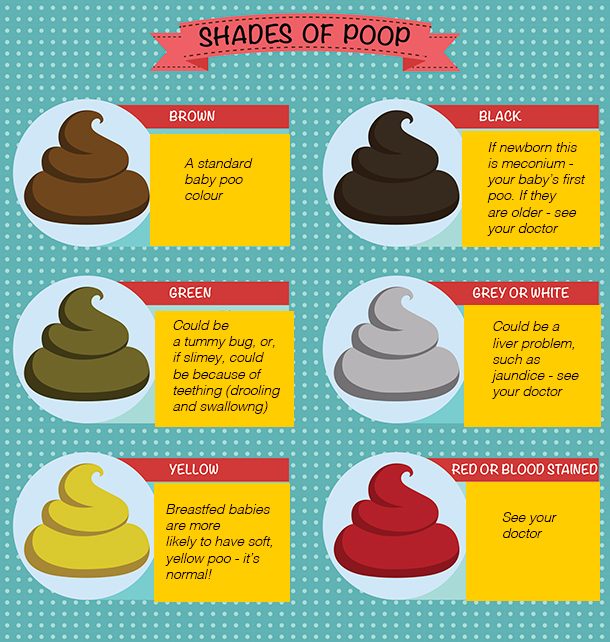 Young children, who are not yet able to blow their nose and cough, swallow nasal mucus and phlegm. This mucus is excreted along with the stool.
Young children, who are not yet able to blow their nose and cough, swallow nasal mucus and phlegm. This mucus is excreted along with the stool. But this does not mean that the child does not receive enough proteins, fats and carbohydrates. As you get older, your enzyme levels will normalize and your stools will become smooth.
But this does not mean that the child does not receive enough proteins, fats and carbohydrates. As you get older, your enzyme levels will normalize and your stools will become smooth.